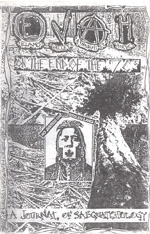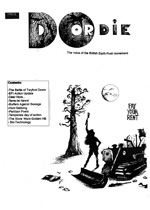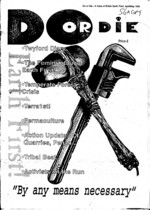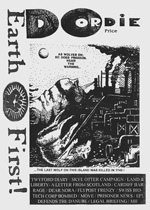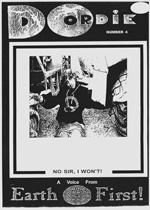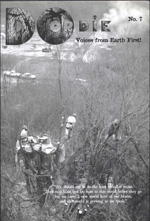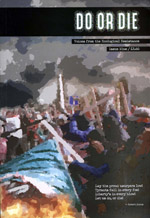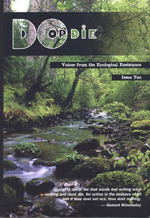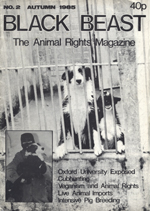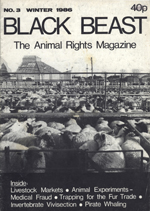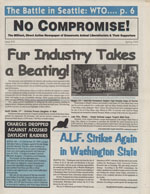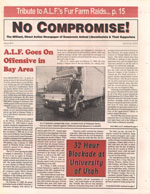The Archives
-
Do or Die, Most Popular, Periodicals
Do or Die – The Complete Set!
04.09.14 | PermalinkDo Or Die #1-10 (1993-2003, Brighton, England.)
A few years ago a friend asked me if I had a complete set of Do or Die, the British Earth First! publication that inspired and incited eco-warriors throughout the 1990s and early 2000s. At one time I did have them, but they had long since been stolen by a Joint Terrorism Task Force.
After a brief discussion, we decided that Do or Die was too important to fade into obscurity. We began tracking down each issue, and decided that while we were at it we ought to archive some other publications as well. That effort is how this web site began, and now, thanks to 56a infoshop of South London and Tim @ NEDS Northampton, we can finally share the very rare issue #2. This completes our collection, and our original mission as well.
When read as a set, Do or Die is a chronicle of people from across the globe counter-striking capitalism, ecocide, and the state. Each issue is better than the last, but more importantly, each page is a spark licking at the fuse of the bomb that is your heart. Once lit, you’ll know that these pages are not mere history, but a reminder that we can explode onto the world stage like the fighters before us have. Do or die, now is the time to rise.
…
-
Periodicals
Black Beast #2-3
02.07.14 | PermalinkBLACK BEAST – Issues 2 & 3 (1985-1986, Oxford, UK)
Taking it’s name from the french term “bête noire,” Black Beast ran for 3 issues before changing it’s title to Turning Point.
Black Beast covered all aspects of animal liberation protest and resistance, from sign holding demonstrations, to lab raids, alongside investigations into various abuses of non-humans. It’s politics were pro-direct action, but anti-militarism, and editorials inside criticized groups like the Animal Rights Militia. Articles were published without bylines, and every aspect of the magazine was anonymous. This made it an attractive forum for groups like the Central Animal Liberation League, who sent in a first hand account of the infamous Park Farm raid at Oxford that freed 32 dogs. One issue even contains an interview with a pre-off-the-deep-end Gary Francione detailing his support for the Animal Liberation Front!
The magazine was well written, nicely produced, and also very rare! TALON is seeking a copy of issue #1. If you can share one with us, please contact us HERE.
…
-
No Compromise, Periodicals
No Compromise #20-22
11.15.12 | PermalinkNo Compromise #20-22 (2003. Santa Cruz / San Francisco, CA)
No Comp scored another great year in 2003, this time by going deeper into practical instructions for campaigning, and also by examining the smaller stories in greater detail. While the high profile victories of anti-HLS activists were given their due, inspirational figures who had passed on were also given touching coverage. Issue #20 features articles on early Band of Mercy and Animal Liberation Front founder Sue Smith, and Sweden’s animal lib die-hard, Ake Soderlund. Similar examinations of our past, and the courageous figures whose shoulders we stand upon, pepper the 2003 issues. Of particular note is the article on Henry Hutto in issue #21.
2003 was also the year that Rod Coronado finally got off of probation and was allowed to participate in the movement again. His writings for No Compromise were as subversive and inspiring as ever, and it is easy to see why the government considered him such a threat.
As the year progressed No Comp moved to a magazine format and tightened their graphic design skills in response to Jake Conroy’s work on the SHAC USA newsletter. These glossy issues were excellent contributions to the movement, and it is a shame that in only a few more years NC would cease to exist altogether. These information (and inspiration!) packed issues are worth reading again to inform and encourage our current actions.


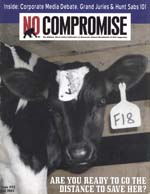
-
Periodicals
Liberate!
11.06.12 | PermalinkLiberate! #1-7 (1996-1997 Birkenhead, New Zealand)
Liberate! was published by Auckland Animal Action, one of the dozens of militant organizations that suddenly coalesced in the mid-90s. While the activities of the group itself were fairly moderate, the visual direction and rhetoric of the magazine was quite extreme. In it’s era this was appropriate. In these modern days of soy milk in every cafe and vegan cheese in every supermarket, talking about cutting off the fingers of vivisectors is certainly going to frighten away an audience that is already coming around. It wasn’t very long ago, however, that the late 80’s trend of moderation in activism was a clear failure. Dialogue about violence and sabotage was a necessary component of moving forward, and it is important to note that these discussions, thankfully, didn’t result in any missing digits.
Liberate! was not particularly well written, but there are some stand out articles about the burgeoning pro-direct action grassroots, conflicts between environmentalists and animal liberationists, and some entertaining imagery as well. Also of interest, given the current Canadian “Marineland Animal Defense” campaign, are the details of New Zealand’s 90s campaign against their own Marineland.
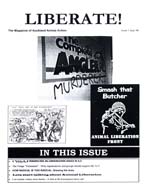
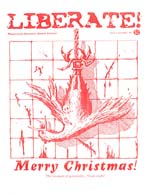

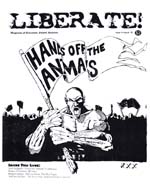

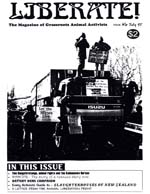
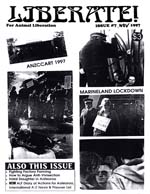
-
No Compromise, Periodicals
No Compromise #18-19
10.23.12 | PermalinkNo Compromise #18-19 (2001-2002. Santa Cruz, CA.)
If you have been following our posting of the complete No Compromise than you have read along as the new, 1990s militant grassroots took its first steps, stumbling along an exciting, and at times error filled path towards animal liberation. Those early years saw a lot of dedication and courage, but sadly little in the way of new tactics or intelligent planning.
That all changed in 2001 with the arrival of the anti-HLS campaign in the United States. The focus suddenly shifted from scattershot regional targeting to a single, international pressure point and the results were encouraging.
2001 wasn’t just about the fight against Huntingdon. The tactics developing in that one small struggle were inspiring activists globally to step up the fight against all areas of animal abuse, and sadly, some of our friends ended up in prison as a result. The support of these jailed comrades was inspiring, but our movement was dealt a terrible blow as Barry Horne died on Hungerstrike. That was not the only tragedy we would witness in these 12 months. Jeff Luers was sentenced to nearly 23 years in prison for an act of sabotage which harmed no one. Animal liberationists had been a strong force in the growing movement against globalization of capitalism, and at the 2001 G8 summit we watched as protestors and media were brutalized and bloodied in the lead up to the police murder of Carlo Giuliani. And of course, non-humans continued to be slaughtered in endless, unfathomable numbers. The tone of these two issues of No Compromise may have been optimistic, even cocky, but those of us on the ground knew that times were tough and getting tougher.
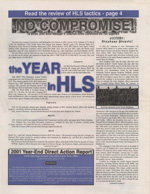

-
Periodicals
Animal Info
10.18.12 | PermalinkAnimal Info #1-8 (1995-1996. Christchurch, New Zealand)
Animal Info was a thin, photocopied newsletter that was published with the hopes of increasing the militancy of New Zealand’s animal activists. It’s pages contained news relevant to local campaigns, alongside the home addresses and phone numbers of various animal abusers. The zine’s rhetoric was, at times, over the top and even once racially insensitive. Issue #1 contains an N-bomb on the front page that was seemingly intended to make an anti-racist / speciesist point, but instead has the exact opposite effect.
Still, Animal Info is an inspiring example of committed activists organizing on a grassroots level and agitating for greater commitment in the struggle against speciesism. It’s international news coverage was impressive given the magazines small number of pages, and nicely bridges the U.S. coverage lapse between the time Open the Cages stopped publication and No Compromise began. All of us at CG would love to see this type of paper return to regional organizing in the United States and abroad.
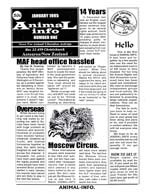
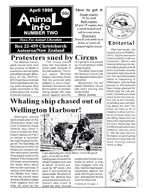



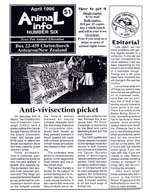
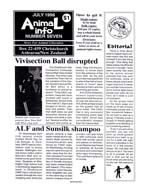
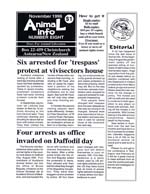
-
Earth First! Journal, Most Popular, Periodicals
Earth First! Journal 1986
09.13.12 | PermalinkEarth First! Journal Volume 7, Issue #1-8 (Tucson, AZ.)
One of our dreams here at Conflict Gypsy has been to build a complete collection of the Earth First! Journal, the radical environmental movement’s longest running periodical. While we are still missing some key issues, we have managed to gather enough of this classic publication to begin posting them one year at a time, starting with 1986.
The eight newspaper-format volumes printed by the Journal collective in 1986 are filled with fascinating tales of our eco-warrior progenitors, including Paul Watson’s epic telling of The Raid on Reykjavic in issue two. It is tempting to spend several paragraphs discussing the contents of these yellowing tomes, but perhaps it is more important to spend these words discussing the fact that the journal is still being produced- AND IT NEEDS OUR SUPPORT!
The Earth First! Journal has been documenting environmentally motivated direct action for more than 30 years, but it struggles to pay the bills these days as fewer and fewer people read print magazines. Here at CG we believe wholeheartedly that history should be “told from below,” that the words of our comrades are more important to our understanding of past events than the musings of academics and professional historians. The Journal is still the best source for this kind of news- the written accounts of actual participants in our struggle! Please do not let it disappear like so many other publications in the last decade. Subscribe to the Earth First! Journal by clicking here!







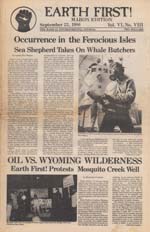
-
No Compromise, Periodicals
No Compromise #15-17
09.01.12 | PermalinkNo Compromise #15,16, 17 (2000-2001, Santa Cruz, CA.)
I want to preface this post with this: The turn of the century was an epic time to be alive and fighting! Between the WTO riots, a huge upsurge in ALF attacks on the West Coast, some inspiring support of grand jury resisters, and the migration of the SHAC campaign to the United States, there were also thousands upon thousands of other actions across the planet. It was hard to keep up with all of the news because it seemed that people everywhere had finally taken enough and were beginning a counter strike for non-humans, wilderness, and human freedom. Luckily, No Compromise kept track of most of the action, and produced three excellent issues during this incredible year of revolt. Beyond the coverage of the latest direct actions, attention was also paid to our past successes and failures- and all animal activists would do well to read issue #16’s “Blast From The Past” article about lab raids in the 1980s.
…
-
No Compromise, Periodicals
No Compromise #12-14
05.15.12 | PermalinkNo Compromise #12-14 (1999, Old Bridge, NJ and Santa Cruz, CA)
If I had to create a list of my favorite years in animal and earth liberation history, 1999 would be in the top 5. As the movement looked towards the new millennium there seemed to be an intense urgency in the air, perhaps people felt the need to close the 20th century with a bang or leave their mark before the world ended in a technological melt down on Y2K! Whatever the reasons, direct action reached a fever pitch. Lab raids returned to the United States, the Earth Liberation Front continued it’s ascendancy, Hillgrove farm was shut forever, and everyone seemed to be preparing for the World Trade Organization ministerial in Seattle. Across the globe there was a sense that people were not going to take it anymore, and whether you were struggling against bio-technology or prisons or speciesism, chances are good that you were employing some form of illegal tactic.
No Compromise may not have covered everything going on in the global struggle, but if it was animal lib related then chances are it was covered in these three issues. From the death of Alex Slack to end of the annual Hegins pigeon massacre, you’d be hard pressed to find a more complete overview of these twelve action packed months.
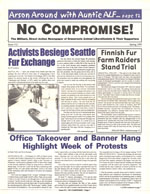
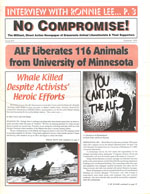
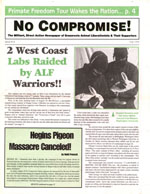
-
One-off publications
Elaho Valley Anarchist Horde on the end of the 7Cs: A Journal of Sasquatchology
04.23.12 | PermalinkElaho Valley Anarchist Horde on the end of the 7Cs: A Journal of Sasquatchology (2001, Victoria, Canada)
“The sun shines brightly in the yard, the sky is clear, the air fresh and bracing. Now the last gate will be thrown open, and I shall be out of site of the guard, beyond the bars, – alone! How I have hungered for this hour, how often in the past years have I dreamed of this rapturous moment – to be alone, out in the open, away from the insolent eyes of my keepers! I’ll rush away from these walls and kneel on the warm sod, and kiss the soil, and embrace the trees, and with a song of joy give thanks to Nature for the blessings of sunshine and air.” Alexander Berkman, Prison Memoirs of an Anarchist.
Upon my own release from prison I traveled to Seattle from Sheridan, Oregon to turn myself in to a halfway house. I too was an anarchist in the hands of the enemy, and while my incarceration was not as long or harsh as Berkman’s, his memoir contains long portions – sometimes entire pages – that feel so familiar it seems as though I wrote them myself. Several times in the final chapter he mentions a longing for wilderness, an urge to run from the dead cities of the northeast into the forests. On that ride from one lockup to another I knew why. Civilization is inherently confining, and even outside of the greybar hotel most of our lives consist of moving from one box to another in a continuous and agonizing march that we have little power to control. Looking out the windows of my friends car I wanted the passing sprawl to be sucked into the soil and replaced with life, beauty, and liberty.
The nature of incarceration can certainly make a person think about the incarceration of nature, but even those anarchists who have been lucky or smart enough to stay out of state custody often get it. If you are opposed to the artificial hierarchies of class, why support the equally arbitrary hierarchies based on species? If you think that forests have less worth than humans than I say you haven’t met enough cops! There isn’t one authority figure on earth I wouldn’t trade for a tree, and anyone who would argue the opposite is a moron. But forgive my rambling, I have written all the above because this wonderful DIY zine has sparked my sense of rebellion and wildness!
The end of the 90s and the early 2000s was a busy time for forest defenders, and across the globe direct action campaigns for wilderness were abundant and inspiring. There are many famous examples, and while Warner Creek and the anti-roads campaigns of England may have stolen the spotlight, one rugged crew in British Columbia carried on an overlooked battle that every activist should know about. If you like raging warrior grannies, sabotage, unlikely coalitions, and open revolt against corporations and their governmental subsidiaries, then you ought to read up on the history of actions in the Elaho, Squamish, and Simms valleys. This zine, written by members of the Elaho Valley Anarchist Horde as both a primer for new activists coming to the Elaho and a means of publicizing the campaign, is an excellent introduction.
